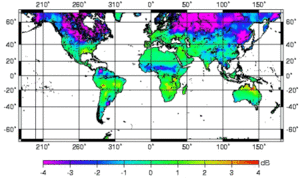Altimetry over land
Topex/Poseidon and Jason-1 were designed to take measurements over the ocean, but the satellites also fly over land while their radars continue to emit. Reception of return echoes is less reliable, since a field or a forest do not reflect radar pulses as well as water, but conclusions can still be drawn. Power received after reflection (or more precisely the "backscatter coefficient", an indicator of the return rate of the radar wave to the altimeter antenna) in itself yields interesting information, since the return rate depends on the state of the observed surface, according to whether it is covered by snow, vegetation or flooded areas, etc.
Comparison of this coefficient for the two frequencies of Topex and Poseidon-2 altimeters, as well as results obtained with the satellite's radiometer thus provide us with information about the date of the first snows and the thickness of snow or vegetal cover in relation to the season. This new field of altimetry should grow in importance over the next few years, as a complement to other satellite observation techniques.
Seasonal anomalies of the backscatter coefficient for Topex in Ku band, in winter (top) and summer (bottom) for the first ten years of measurements. Strong variations can be seen, especially for regions which are covered by snow in winter (higher than 55°N), or which have a marked rainy season (equator, India). (Credits Legos).






